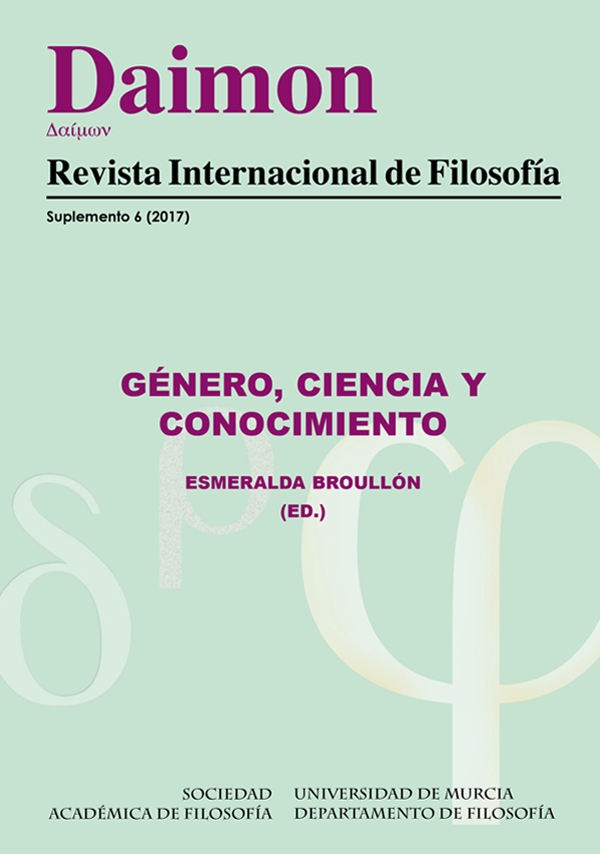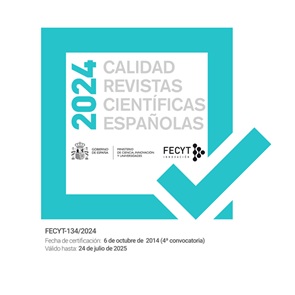El Neurofeminismo frente a la investigación sobre la diferencia sexual
Agencias de apoyo
- Universitat Jaume I
- Proyecto de investigación de I D I del Ministerio de Economía y Competitividad
Resumen
En el presente trabajo se exponen las carencias más importantes en la investigación de la denominada “diferencia sexual en el cerebro”. Desde la revisión y análisis crítico del grupo de científicas NeuroGenderings Network se propone una superación de los prejuicios que, de manera obvia o solapada, continúan manteniéndose en la investigación en relación a las diferencias sexuales en el cerebro. La tarea de “guerrilla epistemológica” que este grupo feminista lleva a cabo con el fin de ir conformando un conocimiento rigurosamente científico se podrá ver con el ejemplo concreto de la propuesta que hacen a una revista neurocientífica.
Descargas
-
Resumen2883
-
PDF1945
Citas
AINSWORTH, Claire (2015): “Sex Redefined”, Nature, 518, 19 February: 288-291.
BAKER, Monya (2016): “1.500 scientists lift the lid on reproducibility. Survey sheds light on the ‘crisis’ rocking Research”, Nature 533: 452–454 (26 May 2016).
BLEIER, Ruth (1984): Science and Gender: A Critique of Biology and Its Theories on Women, Elsevier Science & Technology Books, Amsterdam.
BRIZENDINE, Louann (2006): The Female Brain, Broadway Books, Random House, New York.
BUTLER, Judith (1990): Gender Trouble, Routledge, New York.
CAHILL, Larry (2017): “An issue whose time has come,” Journal of Neuroscience Research 95 (2017): 12–13
CLAYTON, Janine A. & COLLINS, Francis S. (2014): “NIH to balance sex in cell and animal studies”, Nature 509 (7500): 282–283.
DAVIS, Lennard J. & MORRIS, David B. (2007): “Biocultures Manifesto”. New Literary History: a journal of theory and interpretation, 38(3): 411-418.
ELIOT, Lise & RICHARDSON, Sarah S. (2016): “Sex in Context: Limitations of Animal Studies for Addressing Human Sex/Gender Neurobehavioral Health Disparities”, Journal of Neuroscience, 36 (47): 11823-11830.
FAUSTO-STERLING, Anne (2000): Sexing the Body: Gender Politics and the Construction of Sexuality, Basic Books, New York.
FINE, Cordelia (2008): “Will working mothers' brains explode? The popular new genre of neurosexism”, Neuroethics 1 (1): 69-72.
FINE, Cordelia (2010): Delusions of Gender: How Our Minds, Society, and Neurosexism Create Difference, W. W. Norton, New York.
FINE, Cordelia & JORDAN-YOUNG, Rebecca (2017): “We’ve been labelled ‘anti-sex difference’ for demanding greater scientific rigour”, The Guardian, 6/4/2017.
FINE, Cordelia; JORDAN-YOUNG, Rebecca; KAISER, Anelis & RIPPON, Gina (2013): “Plasticity, plasticity, plasticity and the rígid problema of sex”, Trends in Cognitive Sciences, 17(11): 550–551.
FOX KELLER, Evelyn (2010): The Mirage of a Space between Nature and
Nurture, Duke University Press, Durkham & London.
GARCÍA DAUDER, Silvia & PÉREZ SEDEÑO, Eulalia (2017): Las ‘mentiras’ científicas sobre las mujeres, Los libros de la catarata, Madrid.
GERGEN, Kenneth J. (2010): “The acculturated Brain”, Theory & Psychology 20 (6): 795-816.
GOTTLIEB, Gilbert (2000): “Environmental and behavioral influence on gene activity”, Current Directions in Psychological Science, 9, 93–97.
GOTTLIEB, Gilbert (2002): “Developmental-behavioral initiation of evolutionary change”, Psychological Review, 109: 211–218.
GREENFIELD, Susan (2000): The private life of the brain, Penguin Press, New York .
GROSZ, Elizabeth (1994): Volatile Bodies: Toward a Corporeal Feminism, Indiana University Press, Bloomington.
HANSSON, Sven Ove (2015): “Science and Pseudo-Science”, The Stanford Encyclopedia of Philosophy (Spring 2015 Edition), Edward N. Zalta (ed.). Disponible: <http://plato.stanford.edu/archives/spr2015/entries/pseudo-science/>. Consultado 24 Febrero 2016.
HUBBARD, Ruth (1990): The Politics of Women’s Biology, New Brunswick, Rutgers University Press, New Jersey & London.
JOEL, Daphna et al (2015): “Sex beyond the genitalia: The human brain mosaic”, Proceedings of the National Academy of Sciences (PNAS), 112 (50): 15468–15473.
JOEL, Daphna & McCARTHY, Margaret M. (2017): “Incorporating Sex As a Biological Variable in Neuropsychiatric Research: Where Are We Now and Where Should We Be?”, Neuropsychopharmacology, (2017)42: 379–385.
KAISER, Anelis (2012): “Re-Conceptualizing ‘Sex’ and ‘Gender’ in the Human Brain”, Zeitschrift fur Psychologie, 220(2): 130–136.
KRAUS, Cynthia (2011): “Critical Studies of the Sexed Brain: A Critique of What and for Whom?”, Neuroethics, 5(3): 247-259
LAQUEUR, Thomas (1994): La construcción del sexo. Cuerpo y genero desde los griegos hasta Freud, Cátedra, Colección Feminismos, Madrid. Traducción del original de 1990 por Eugenio Portela.
LI, Schu-Chen (2003): “Biocultural Orchestration of Developmental Plasticity Across Levels: The Interplay of Biology and Culture in Shaping the Mind and Behavior Across the Life Span”, Psychological Bulletin of the American Psychological Association, 129(2): 171–194.
LITTLEFIELD, Melissa & JOHNSON, Jenell, eds. (2012): Neuroscientific Turn: Transdisciplinarity in the Age of the Brain, The University Of Michigan Press, Ann Arbor .
MANEY, Donna L. (2015): “Just like a circus: the public consumption of sex differences”, Current Topics in Behavioral Neurosciences, 19: 279-96.
MANEY, Donna L. (2016): “Perils and pitfalls of reporting sex differences”, Philosophical Transactions B. The Royal Society Publishing, 371(1688): 20150119.
McCARTHY, Margaret M. (2016): “Multifaceted origins of sex differences in the brain”, Philosophical Transactions B. The Royal Society Publishing. 371(1688): 20150106.
MEHL, Matthias R.; VAZIRE, Simine; RAMÍREZ-ESPARZA, Nairán; SLATCHER, Richard B. ; PENNEBAKER, James W. (2007): “Are Women Really More Talkative Than Men?”, Science, 6 Jul 2007: 82
NICHOLSON, Linda (1994): “Interpreting Gender”, Signs. Journal of Women in Culture and Society, 20(1): 79-105.
O’CONNOR, Cliodhna & JOFFE, Helene (2014): “Gender on the Brain: A Case Study of Science Communication in the New Media Environment”, PLoS ONE, 9(10): e110830.
OSC Open Science Collaboration (2012): “Estimating the Reproducibility of Psychological Science”, Reproducibility Project: Psychology, Open Science Framework. Disponible en <https://osf.io/ezcuj/> Consultado el 21 diciembre 2016.
PRAGER, Eric M. (2017): “Addressing Sex as a Biological Variable”, Journal of Neuroscience Research, 95 (2017): 11.
RIDLEY, Matt (2003): Nature via nurture: Genes, experience, and what makes us human, HarperCollins Publishers, New York.
RIPPON, Gina, JORDAN-YOUNG, Rebecca, KAISER, Anelis & FINE, Cordelia (2014): “Recommendations for sex/gender neuroimaging research: key principles and implications for research design, analysis, and interpretation”, Frontiers in Human Neurosciences, 8: 650.
RIPPON, Gina, JORDAN-YOUNG, Rebbecca, KAISER, Anelis, JOEL, Daphna & FINE, Cordelia (2017): “Journal of neuroscience research policy on addressing sex as a biological variable: Comments, clarifications, and elaborations”, Journal of Neuroscience Research. Doi:10.1002/jnr.24045 (solo online). Consultado 4-3-2017.
ROSE, Nikolas & ABI-RACHED, Joelle M. (2013): Neuro: The New Brain Sciences and the Management of the Mind, Princeton University Press, Princeton NJ.
RUSSETT, Cynthia E (1989): Sexual Science: The Victorian Construction of Womanhood, Harvard University Press, Cambridge MA.
SCHMITZ, Sigrid (2012): “The neurotechnological cerebral subject: Persistence of implicit and explicit gender norms in a network of change”, Neuroethics, 5(3): 261-274.
SCOTT, Anne (1997): “The Knowledge in Our Bones: Standpoint Theory, Alternative Health and the Quantum Model of the Body”, Maynard, Mary, ed., Science and the Construction of Women, University College London, London, pp.106-125.
SEVERIN, Laura & WYER, Mary (2000): “The Science and Politics of the Search for Sex Differences: editorial”, NWSA Journal, 12(3): vii-xvi.
SIMMONS, Joseph P., NELSON, Leif D., SIMONSOHN, Uri (2011): “False-Positive Psychology. Undisclosed Flexibility in Data Collection and Analysis Allows Presenting Anything as Significant”, Psychological Science, 22(11): 1359-1366.
SKOLNICK WEISBERG, D., Keil, F.C., Goodstein, J., Rawson, E., & Gray, J. (2008): “The seductive allure of neuroscience explanations”, Journal of Cognitive Neuroscience, 20: 470–477.
SPELMAN, Elizabeth V. (2007): “Managing Ignorance”, en Sullivan, Shanon & Tuana, Nancy, eds. Race and Epistemologies of Ignorance, SUNY Press, New York, pp. 119-134.
SPIVAK, Gayatri Ch. (1993): Outside in the Teaching Machine, Routledge, New York & London.
SPRAGUE, Joey (20016, 2005): Feminist Methodologies for Critical Researchers: Bridging Differences, Rowman & Littlefield, London.
TOBACH, Ethel & ROSOFF, Betty, eds. (1994): Challenging racism & sexism: Alternatives to genetic explanations, The Feminist Press, CUNY Press, New York..
TUANA, Nancy (2004): “Coming to understand: Orgasm and the epistemology of ignorance, Hypatia: A Journal of Feminist Philosophy, 19(1): 194-232.
TUANA, Nancy (2006): “The Speculum of Ignorance: The Women’s Health Movement and Epistemologies of Ignorance”, Hypatia: A Journal of Feminist Philosophy, 21(3): 1-19.
WOOD, Jane (2001): Passion and Pathology in Victorian Fiction, Oxford University Press.
Las obras que se publican en esta revista están sujetas a los siguientes términos:
1. El Servicio de Publicaciones de la Universidad de Murcia (la editorial) conserva los derechos patrimoniales (copyright) de las obras publicadas, y favorece y permite la reutilización de las mismas bajo la licencia de uso indicada en el punto 2.
2. Las obras se publican en la edición electrónica de la revista bajo una licencia Creative Commons Reconocimiento-NoComercial-SinObraDerivada 3.0 España (texto legal). Se pueden copiar, usar, difundir, transmitir y exponer públicamente, siempre que: i) se cite la autoría y la fuente original de su publicación (revista, editorial y URL de la obra); ii) no se usen para fines comerciales; iii) si remezcla, transforma o crea a partir del material, no podrá distribuir el material modificado.
3. Condiciones de auto-archivo. Se permite y se anima a los autores a difundir electrónicamente las versiones pre-print (versión antes de ser evaluada) y/o post-print (versión evaluada y aceptada para su publicación) de sus obras antes de su publicación, ya que favorece su circulación y difusión más temprana y con ello un posible aumento en su citación y alcance entre la comunidad académica. Color RoMEO: verde.











